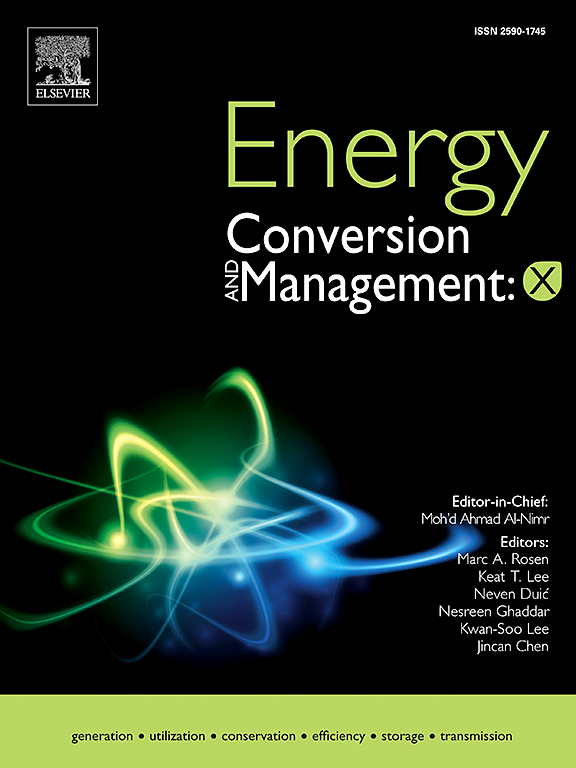季节性井内储热与深井地源热泵系统集成:不确定条件下的动态性能分析
IF 10.9
1区 工程技术
Q1 ENERGY & FUELS
引用次数: 0
摘要
将井内热能储存(BTES)集成到闭环中深层地热供暖系统中,有助于缓解地下温度下降,支持可持续运营。现有的研究主要集中在确定性条件下深孔换热器的蓄热性能,忽略了集成系统的动态特性和多重不确定性。为了解决这一问题,本研究开发了一种太阳能辅助深钻孔地源热泵系统,该系统结合了主动加热、被动加热和BTES,并研究了不确定条件下系统的长期性能和蓄热特性。首先,在TRNSYS中建立了一个综合的DBHE模型,考虑了热量的提取、储存和回收。随后,考虑不确定性相关性,生成了20年的随机情景。然后进行了长期动态模拟,以评估系统在井深和太阳能产热能力的综合影响下的行为。结果显示,在不确定条件下,与在确定条件下观察到的相对稳定的变化相比,年能源表现有显著波动。忽略长期模拟中的不确定性可能会低估年最大蓄热率高达18.2%。当井深超过2500米,太阳能集热器面积超过临界阈值时,深层BTES的集成可为系统节省高达66.9%的能源。临界集热器面积与井深呈负相关。此外,在井深2000 - 2200米和2900 - 3000米时,深层BTES对热提取性能的好处更为明显,每单位充电能量的热提取收益高达17.5%。该研究为实际条件下BTES中深层地热系统的长期运行特性提供了有意义的见解。本文章由计算机程序翻译,如有差异,请以英文原文为准。
Integrating seasonal borehole thermal energy storage into deep borehole ground source heat pump systems: Dynamic performance analysis under uncertainties
Integrating borehole thermal energy storage (BTES) into closed-loop medium-deep geothermal heating systems helps mitigate underground temperature decline and support sustainable operation. Existing research primarily focused on the heat storage performance of the deep borehole heat exchanger (DBHE) under deterministic conditions, neglecting the dynamic characteristics of the integrated system and multiple uncertainties. To address this gap, this study developed a solar-assisted deep borehole ground source heat pump system incorporating active heating, passive heating, and BTES, and investigated the long-term system performance and thermal storage characteristics under uncertainties. Firstly, a comprehensive DBHE model, considering heat extraction, storage, and recovery, was developed in TRNSYS. Subsequently, 20-year stochastic scenarios were generated considering uncertainty correlations. Long-term dynamic simulations were then performed to evaluate the system’s behavior under the combined effects of borehole depth and solar heat generation capacity. The results revealed significant fluctuations in annual energy performance under uncertainties, in contrast to the relatively stable variations observed under deterministic conditions. Ignoring uncertainties in long-term simulations could underestimate the annual maximum heat storage rate by up to 18.2 %. The integration of deep BTES achieved up to 66.9 % energy savings for the system when borehole depth exceeded 2,500 m and solar collector area surpassed critical thresholds. A generally negative correlation was observed between the critical collector area and borehole depth. Additionally, the benefits of deep BTES on heat extraction performance were more pronounced at borehole depths of 2,000–2,200 m and 2,900–3,000 m, with heat extraction gains of up to 17.5 % per unit of energy charged. This study provides meaningful insights into the long-term operational characteristics of medium-deep geothermal systems with BTES under real-world conditions.
求助全文
通过发布文献求助,成功后即可免费获取论文全文。
去求助
来源期刊

Energy Conversion and Management
工程技术-力学
CiteScore
19.00
自引率
11.50%
发文量
1304
审稿时长
17 days
期刊介绍:
The journal Energy Conversion and Management provides a forum for publishing original contributions and comprehensive technical review articles of interdisciplinary and original research on all important energy topics.
The topics considered include energy generation, utilization, conversion, storage, transmission, conservation, management and sustainability. These topics typically involve various types of energy such as mechanical, thermal, nuclear, chemical, electromagnetic, magnetic and electric. These energy types cover all known energy resources, including renewable resources (e.g., solar, bio, hydro, wind, geothermal and ocean energy), fossil fuels and nuclear resources.
 求助内容:
求助内容: 应助结果提醒方式:
应助结果提醒方式:


